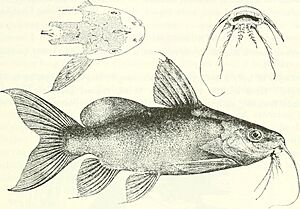Synodontis frontosus facts for kids
Quick facts for kids Synodontis frontosus |
|
|---|---|
 |
|
| Conservation status | |
| Scientific classification | |
| Genus: |
Synodontis
|
| Species: |
frontosus
|
The Sudan squeaker (also known as Synodontis frontosus) is a special kind of catfish. It's often called an "upside-down catfish" because of how it swims! You can find this fish all over northern and central Africa. It lives in countries like Chad, Democratic Republic of the Congo, Ethiopia, Kenya, Somalia, Sudan, and Uganda. A French scientist named Léon Vaillant first described this fish in 1895. He found it in the White Nile river in Sudan. The name frontosus comes from Latin and means "broad head," which describes its wide head.
Contents
About the Sudan Squeaker
Like other Synodontis fish, the Sudan squeaker has a strong, bony head. This bony part goes all the way back to its first top fin spine. Its head also has a unique bony bump called a humeral process. The shape and size of this bump help scientists tell different Synodontis species apart. For the Sudan squeaker, this bump is a bit longer than it is wide and ends in a sharp point.
Whiskers and Fins
This fish has three pairs of whiskers, called barbels. One pair is on its upper jaw, and two pairs are on its lower jaw. The upper jaw whiskers are long and straight. They can be about one to one and three-quarters the length of its head. The outer pair of lower jaw whiskers is about twice as long as the inner pair. Both pairs of lower jaw whiskers have small branches on them.
The front edges of the top fin (dorsal fin) and side fins (pectoral fins) are stiff spines. The top fin spine on the Sudan squeaker is short, about three-quarters the length of its head. It is smooth in the front but has jagged edges on the back. The rest of the top fin has seven soft rays. The side fin spine is about as long as the top fin spine. It has jagged edges on both sides. The small, fleshy fin near its tail (adipose fin) is two and a half to four times longer than it is deep. The fin on its belly (anal fin) has four unbranched and eight or nine branched rays. Its tail fin is deeply split, and the upper part is longer.
Teeth and Color
All Synodontis fish have a special pad of teeth on the very front of their upper jaw. This pad has several rows of short, chisel-shaped teeth. For the Sudan squeaker, this tooth pad is short and wide. On its lower jaw, the teeth are attached to flexible, stalk-like parts. These teeth are often described as "s-shaped" or "hooked." The number of teeth on the lower jaw helps identify the species. The Sudan squeaker has between 33 and 48 teeth on its lower jaw.
The body of the Sudan squeaker is grey-brown to blackish on top, bottom, and sides. It has white lips. This fish can grow up to about 34.2 centimeters (about 13.5 inches) long. Female Synodontis fish are usually a bit bigger than males of the same age.
Habitat and Life Cycle
In the wild, the Sudan squeaker lives in the Nile River and Shabeele River basins. It also lives in lakes like Turkana, Albert, Edward, and Kyoga.
Reproduction
We don't know much about how most Synodontis species reproduce. However, we do know that females can carry many eggs. It's thought that these fish lay their eggs during the flooding season, which is usually between July and October. During this time, pairs of fish might swim together when they lay eggs.
Diet and Growth
The Sudan squeaker eats many different things. Its diet includes algae, water plants, and decaying bits of plants and animals. It also eats small creatures like crustaceans, insects, and mollusks. These fish grow very quickly in their first year. After that, their growth slows down as they get older.


